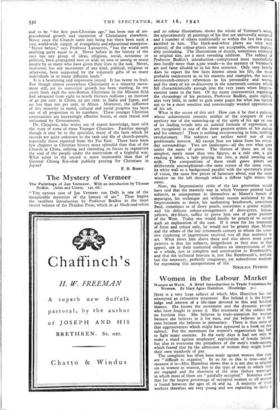The Mystery of Vermeer
The Paintings of Jan Vermeer. With an introduction by Thomas Bodkin. (Allen and Unwin. 125. 6d.)
"THE curious case of Jan Vermeer van Delft is one of the inexplicable mysteries of the history of art." Thus begins the excellent introduction by Professor Bodkin to the most recent volume of the Phaidon Press, which in 42 black-and-white
and 20 colour illustrations shows the whole of Vermeer's work, the approximately 36 paintings of his that are universally accepted and a number of others traditionally or within the last few years ascribed to him. The black-and-white plates are very well printed; of the colour-plates some are acceptable, others deplor- ably misleading. The illustrations of details, sometimes enlarged to original size, are a most revealing addition. The subject of Professor Bodkin's introduction—compressed most successfully into hardly more than 3,500 words—is the mystery of Vermeer's art and fame alluded to in his first sentence. Only very briefly does he report the few facts known about his life, the most probable conjectures as to his masters and examples, the scanty seventeenth-century references to his personality and works, and the story of his re-discovery in the nineteenth century which fell characteristically enough into the very years when Impres- sionism came to the fore. Of the many controversies regarding the chronology of his pictures, Professor Bodkin, quite rightly, says very little, in order to gain some pages for what has turned out to be a most sensitive and convincingly worded appreciation of his art.
What is the secret of this art? How can it be that a painter, whose achievement consists neither of the conquest of new territory nor of the summing-up of the spirit of his age or one of its leading trends into an untried formula of expression, is yet recognised as one of the three greatest artists of his nation and his century? There is nothing overpowering in him, nothing revolutionary. His subjects are neither novel nor of any problematic interest. All except four are taken from his every- day surroundings. Two are landscapes—all the rest what goes under the name of genre. The themes of these are of the simplest, rarely more than two figures, as a rule one, a girl reading a letter, a lady playing the lute, a maid pouring out milk. The compositions of these small genre pieces are deliberately uncomplicated—the same corner of the same room, its white wall as a background parallel with the spectator's plane of vision, the same few pieces of furniture about, and the same window on the left through which a diffuse light enters the
MOM.
Now, the Impressionist critic of the last generation would have said that the masterly way in which Vermeer painted such
subjects, as unimportant in themselves as Manet's bunch of asparagus, his technique not without reason acclaimed by the Impressionists as theirs, his enchanting brushwork, sometimes Maid, sometimes as of dewy pearls, sometimes a grainy stipple, and his delicate colour-arrangements of dove-greys, lemon- yellows, sky-blues, suffice to prove him one of great painters of the West. Today one would hardly be prepo_ed to accept such an explanation of the case. If it were for his treatment of form and colour only, he would not be greater than Monet and the others of the late nineteenth century to whom the sensi- tive rendering of impressions received was all that mattered in art. What raises him above these and also above most genre painters is that his subjects, insignificant as they may at first appear, are in their contented stillness an interpretation of life as a whole, just as complete and constructive as Rembrandes, and that his technical bravura is, just like Rembrandt's, nothing but the necessary, perfectly congruous, yet subordinate medium for expressing this interpretation of life.
NIKOLAUS PEVSNER.


























 Previous page
Previous page